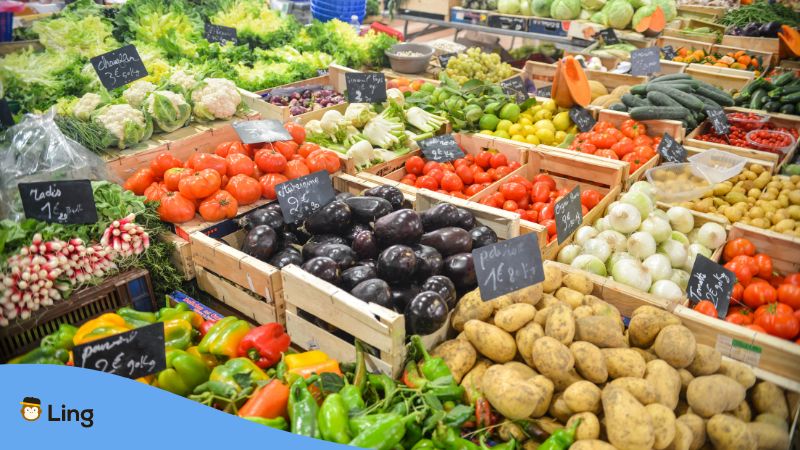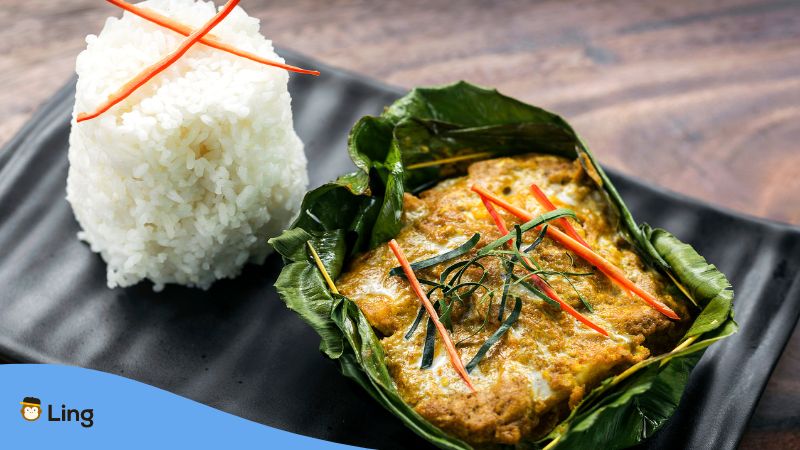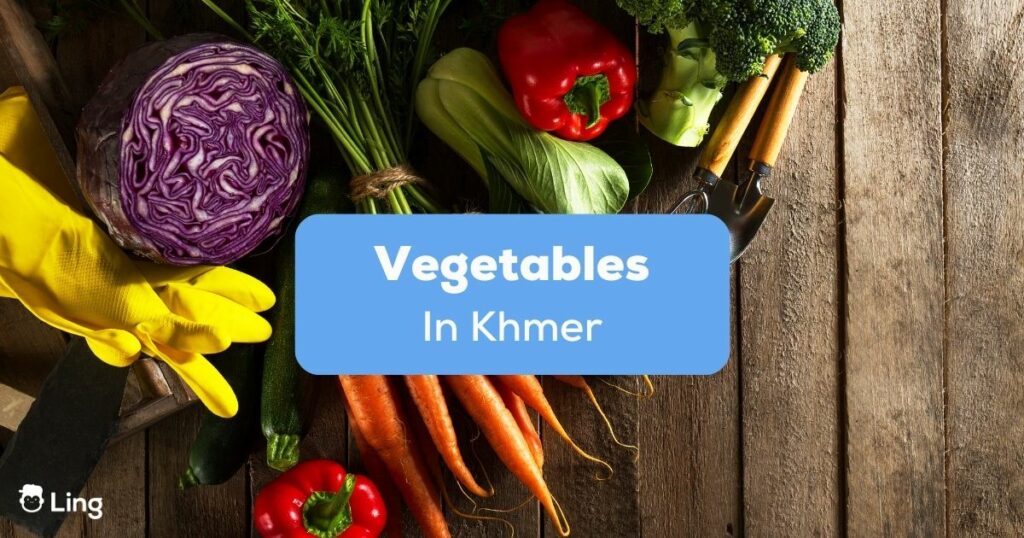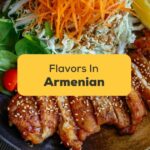Have you ever found yourself in Cambodia and had no idea what you were eating? If so, that’s completely normal when you’re visiting other countries! In fact, that’s a good thing! Most of the time, when we’re traveling, we eat whatever we can find or what’s given to us. We might not know what the dish is, but we want to try something new!
Whether you’ve just returned from Cambodia or plan to travel there soon, you should take some time to learn Khmer and, more specifically, get to know these 50+ vegetables in Khmer! Not only will you learn how to say your favorite vegetables in the Khmer language, but you’ll learn about specific vegetables native to Cambodia and Southeast Asian cuisines.
We hope you’ve already eaten because you’re about to learn about some delicious food and vegetables!
Vegetables In Khmer To Learn By Heart

If you’re a vegetable lover or just enjoy getting to know food terminology in other languages, this is the perfect list. We’ve divided our list according to how each vegetable is typically classified to make things easier. For example, onions are categorized as allium vegetables.
Below are the categories we’ve included, in case you want to skip down to a specific one:
- Western Vegetables In Khmer
- Alliums
- Leafy Greens
- Root Vegetables
- All Other Veggies
In case you aren’t familiar with these categories, don’t worry, we’ll explain what each of them means!
Western Vegetables In Khmer
This category is mainly for vegetables in Western dishes, but we’ve found the corresponding Khmer word.
| English | Khmer | Transliteration |
| Broccoli | ផ្កាខាត់ណាខៀវ | Phka Khatna Khiev |
| Brussel sprout | ពន្លកស៊ែល | Ponlouk Sel |
| Cabbage | ស្ពៃក្តោប | Spei Kdaob |
| Carrots | ការ៉ុត | Karot |
| Cauliflower | ផ្កាខាត់ណា | Phka Khatna |
| Corn | ពោត | Pout |
| Kale | ខាត់ណា | Khatna |
| Lettuce | សាឡាត់ | Salat |
| Potato | ដំឡូង | Damloung |
| Sweet potato | ដំឡូងផ្អែម | Damloung Ph’aem |
| Tomato | ប៉េងប៉ោះ | Pengpaoh |
Alliums
Did you know that the word allium is Latin for “garlic”? In general, alliums include anything with a bulb.
| English | Khmer | Transliteration |
| Garlic | ខ្ទឹម | Khtuem |
| Lemongrass | ស្លឹកគ្រៃ | Sloekkrei |
| Onion | ខ្ទឹមបារាំង | Khtuem Barang |
| Shallot | ស្ពៃក្តោប | Spei Kdaob |
| Spring onions | ស្លឹកខ្ទឹម | Sloek Khtuem |
Leafy Greens
Leafy greens is a term that refers to edible plant leaves.
| English | Khmer | Transliteration |
| Agati | អង្គាដី | Angkea Dei |
| Cambodian mint | ជីសាំងហ៊ុម | Chisang Hom |
| Chinese cabbage (bok choy) | ស្ពៃក្តោបចិន | Spei Kdaob Chen |
| Cilantro/coriander | វ៉ាន់ស៊ុយ | Chi Vansuy |
| Climbing wattle | ស្អំ | S’am |
| Moringa | ម្រុម | Mrom |
| Morning glory | ត្រកួន | Trakuon |
| Pandan | ស្លឹកតើយ | Sloek Taeuy |
| Pennywort | ត្រចៀកក្រាញ់ | Trachiek Kranh |
| Rat ear | ក្រសាំងទាប | Krasang Teab |
| River leaf | វល្លិថ្នឹង | Voal Thnoeng |
| Thai basil | ជីនាងវង | Chi Neang Vong |
| Thai holy basil | ម្រះព្រៅ | Mreah Prov |
| Water mimosa | កញ្ឆែត | Kanhchhet |
| Yardlong bean | សណ្ដែកកួរ | Sandaekkuor |
Root Vegetables
Root vegetables are the parts of a largely underground plant, yet we eat them for nutrients.
| English | Khmer | Transliteration |
| Chinese ginger | ខ្ជាយ | Khcheay |
| Daikon radish | ឆៃថាវ | Chaithav |
| Galangal | រំដេង | Romdeng |
| Ginger | ខ្ញី | Khnhei |
| Jicama | ប៉ិកួៈ | Pe kuok |
| Taro | ត្រាវ | Trav |
| Turmeric | រមៀត | Romiet |
All Other Veggies
| English | Khmer | Transliteration |
| Bamboo shoots | ទំពាំង | Tompeang |
| Banana flowers | ផ្កាចេក | Phka Chek |
| Bean sprouts | សណ្ដែកបណ្ដុះ | Sandaek Bandoh |
| Bitter melon | ម្រះ | Mreah |
| Bottle gourd | ឃ្លោក | Khlok |
| Chilli | ម្ទេស | Mtes |
| Eggplant | ត្រប់ក្ដគោ | Trab Kda Kou |
| Green beans | សណ្តែកខៀវ | Sandaek Khiev |
| Kaffir lime | ក្រូចឆ្មារ | Krouch Chhmar |
| Lotus seed | ឈូក | Chhuk |
| Mung beans | សណ្តែកសៀង | Sandaek Sieng |
| Mushrooms | ផ្សិត | Phset |
| Okra | ពោតបារាំង | Pout Barang |
| Pea eggplant | ត្រប់ពុតលំញង | Trab Putlomnhoung |
| Tamarind | អម្ពិល | Ampel |
| Water chestnuts | ក្រចាប់ | Krachab |
| Winged bean | ប្រពាយ | Prapeay |
That’s all! Now you’ve learned 50+ vegetables in Khmer! You know what they say, the way to someone’s heart is through their stomach (i.e., cooking)! Maybe you can impress your next date by cooking Cambodian food!
What Defines Cambodian Cuisine?

Before you go straight into learning about vegetables in Khmer, the vocabulary might be more interesting if you know the main characteristics of Cambodian cuisine beforehand.
Cambodian food is very healthy, often consisting of rice or rice noodles, fresh vegetables, and not too much meat. Most meals consist of sour fish soups and stews or different coconut milk curries.
You’ll also find that Cambodian cuisine, like other food in Southeast Asia, has a nice balance of sweet, bitter, sour, and salty flavors. However, a key difference is that Cambodian cuisine tends not to be as spicy as the food in its neighboring countries (for example, Thailand). So, if you’re not a fan of spicy food or can’t eat spicy food, you might want to consider going to Cambodia!
There are so many amazing flavors in Cambodian cuisine. No wonder eating is such a huge part of Khmer culture!
Common Ingredients Used In Cambodian Cuisine
Here are some ingredients that you’ll probably find in a Cambodian restaurant, whether you’re in the capital city of Phnom Penh or eating in beautiful rice fields.
- Coconut milk – Khteah Doung – ខ្ទិះដូង
- Fish sauce – Tuek Trei – ទឹកត្រី
- Flat rice noodles – Kuyteav Sasai Thom – គុយទាវសរសៃធំ
- Oyster sauce – Preng Kchang – ប្រេងខ្យង
- Pickled vegetables – Chrok Banlae – ជ្រក់បន្លែ
- Roasted peanuts – Sandaek Dei Ling – សណ្តែកដីលីង
- Soy sauce – Tuek Si Iv – ទឹកស៊ីអ៊ីវ
- White rice/plain rice – Angkor Sor – អង្ករស
These are just some of the ingredients used in Cambodian cooking, so feel free to research and discover more on your own! In fact, comment down below any ingredients we might have left out!
Learn More Useful Vocabulary With The Ling App!

If you loved learning about vegetables in Khmer, you could learn more helpful vocabulary with the Ling App!
Ling is a revolutionary language learning app designed to teach you a language as effectively and efficiently as possible. Whether you’re a beginner or advanced learner, or you want to spend 10 minutes or 1 hour per day studying, Ling has lessons to accommodate everyone! The app is even available for iOS, Android, and desktop devices, so you can learn no matter the device you have.
Some of the app’s main features include engaging and digestible lessons, relevant vocabulary and phrases that can be used to communicate with the locals, exercises to practice writing skills, practice features through our AI chatbot, and an easy-to-navigate interface.
Aside from the app, Ling has a fantastic free language blog with thousands of resources related to languages, different countries, cultures, food, and even helpful language learning tips. If you ever want to extend your knowledge, this is the blog you need.
Want to see for yourself? Try out the Ling App today, and happy learning!



































































